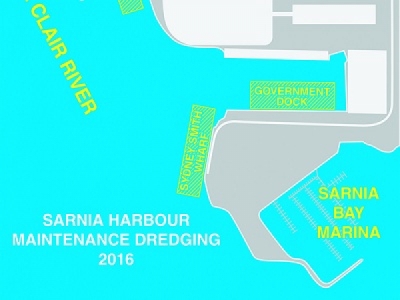
Posted on December 6, 2016
By Troy Shantz, The Sarnia Journal
Crews are working around the clock to dredge more than 30,000 cubic meters of sediment from Sarnia Harbour and deposit in at Sarnia Chris Hadfield Airport.
“During the shipping season, oftentimes ships will require repair and they’re fully loaded. In many cases, we weren’t able to accommodate them because our berths were not quite deep enough,” said Peter Hungerford, Sarnia’s director of economic development.
“This is going to improve the potential for business.”
The $2.9-million project is removing enough sediment from the harbour to cover an area at the airport the size of four football fields to a depth of one metre.
The goal at the Harbour is to create a working depth of 8.4 metres for ships entering the Government Dock and North Slip and 8.6 metres at the Sydney Smith Wharf.
Quebec-based Ocean Group began scooping up the river bottom late last month.
Consultation with a number of government agencies was required including the Ministry of Natural Resources and Forestry and the St. Clair Conservation Authority. The permits took nearly half a year to be finalized.
The sediment has been loaded onto sealed dump trucks and taken to a plot of unused land at the southern tip of the airport.
Early in the process, 20 sediment samples were tested for chemical contamination. The tests found very minimal levels, which could offer significant cost savings for disposal.
Hungerford said further testing will be done to determine whether the soil is usable or requires disposal at a specialized facility.
“We’re very conscious of our environmental responsibility and any liability that might attach to the city if we were to provide soil with any kind of impurity in it,” he said.
London-based Riggs Engineering provided a computer-generated bathymetry map showing the contours of the Harbour floor. The greatest in-filling had occurred at the Sydney Smith Wharf.
The project should satisfy the Harbour’s needs for the next eight to 10 years, but weather and erosion along Lake Huron’s shoreline will determine when the next dredging will be needed, Hungerford said.
The Harbour normally fills in with sediment at a rate of about two centimetres a year.
Source: The Sarnia Journal





